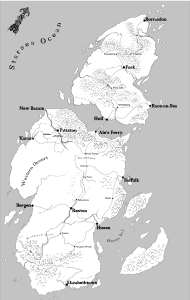Map of Materia
Biomes
Materia is a medium-sized continent running at a slight angle to its longitudinal lines at a point somewhere between 25 and 45 degrees of the equator. Because of this, there area a wide variety of biomes across the continent and that has resulted in different needs in architecture, building materials, goods, and city structures.
The southern portions of the continent are a mixture of tropical to temperate areas, including several swamplands breaking to plains and light forest areas at the interior. near the north-central area of the main body of the land is a moderate desert land dotted by naturally occurring oases and sandy grasslands some artificially constructed resting areas.
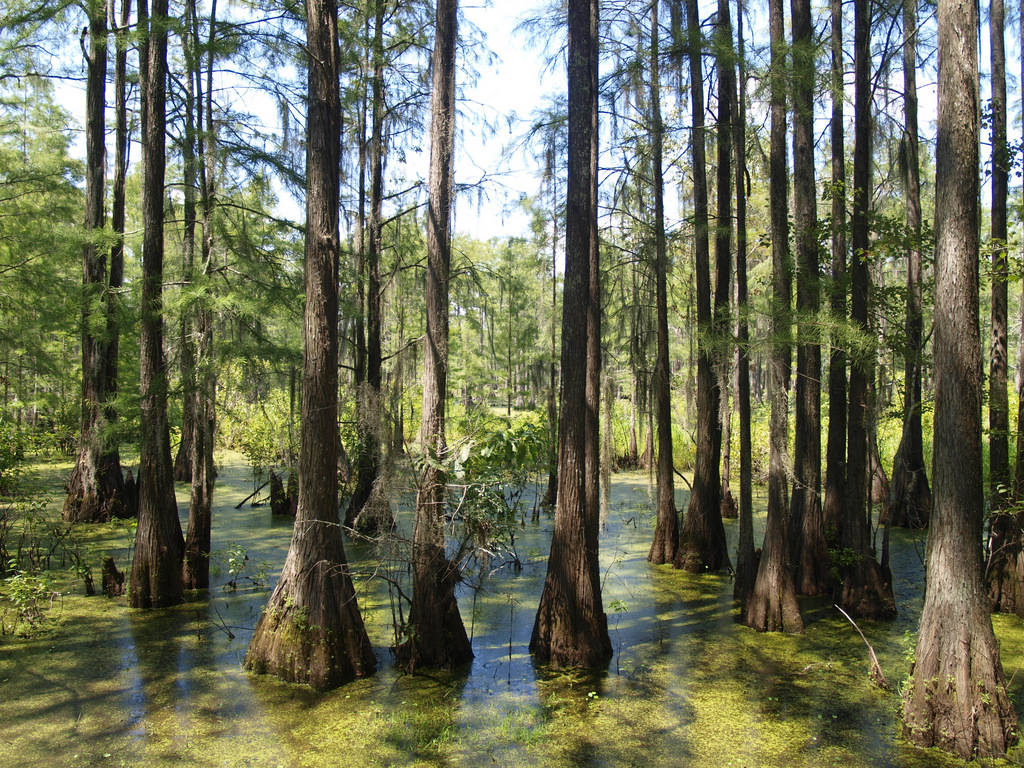
The main body of the continent is divided into two portions by a separation incorrectly referred to as a bay. This region and much of the region to the north of this divide is temperate with mild winters across much of the flatland and southernmost mountains. The central and northern mountains of this portion of the continent can become frigid in the winter and often result in heavy snowfall from the mountains to light snowfall along the northern coastline.
Various islands along the coastline tend to be mild and breezy most of the year. A large land mass off of the eastern coastline forms the third major portion of the continent which is mostly tropical in nature.
On all sides of this continent are ocean waters. Due to the wide variety of food sources and other materials there has been little need to expand beyond the current borders. Because of this, it is unknown what the next closest land mass would be. Few voyages to explore the planet have left the continent and none have returned. Fliers and swimmers rarely migrate far.
Wilderness
As with the island biomes, there is a great variety of opportunity across the wilderness. From open plains which one can roam to the deep dense forests and jungles where even the largest of pelaon citizens can become lost.
Most communities fence or wall their borders to designate the official boundaries. It is generally accepted that outside of these fences, all area with the exception of roads are considered unclaimed wilderness area. In the wilderness, there is no level of protection against being hunted by “purist” pelaon predators.
These purists often use more traditional methods of claiming and combating for territory within the wilderness and even herbivores will become territorial if they feel threatened or imposed upon. Some humans have chosen to live a similar, off-the-grid primitive life and may also become aggressive. Communities must be careful when growing their borders or developing new farmland.
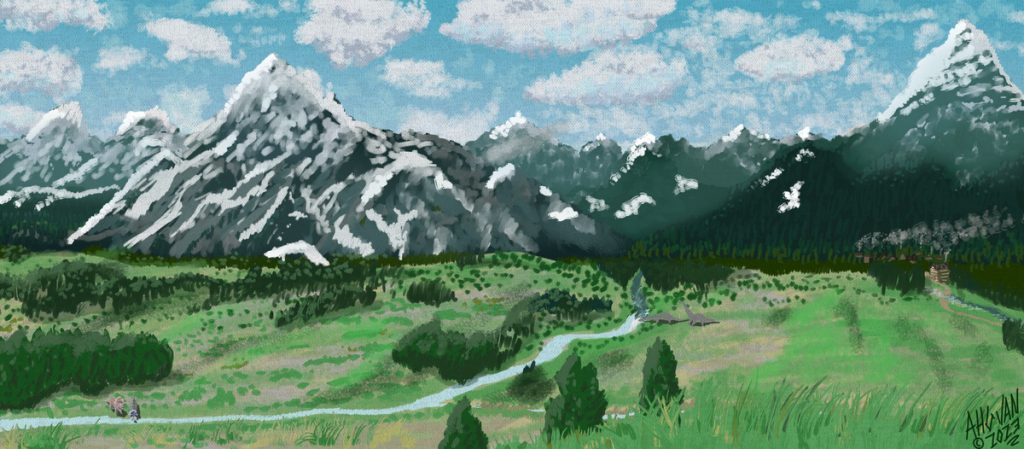
Agriculture, Flora and Fauna
Materia offers a vast selection of farming-worthy resources and for this reason agriculture remains the largest industry in which materians work. Many farms operate either using a plantation-like format (with fair worker pay protected by law) or through sharecropping.
Many of these would be familiar to the people of earth, including corn, wheat, oat, various strains of legumes such as bean and pea, lettuces and members of the cabbage family. Orchards of apple, peach, orange, and Mango are also grown across the landscape. Livestock such as chicken, turkey, goat, and angus cattle also can be found.
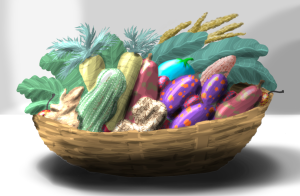
In addition to these familiar food items, a greater percentage of farms and orchards supply far more unique foods including large-leafed greens appearing to be gigantic chard plants, a rainbow of vibrant root vegetables ranging from tastless to bitter to tubers that can be refined to a substance sweeter than beet sugar, a variety of grains and cob-like plants, sweet and juicy neon-blue tomato-like fruits and many others. A popular tree fruit (one of many available breeds) called takjul, is speckled purple and orange when ripe yet has a smooth and creamy flesh that tastes like a mix of banana and pear.
Various game animals can often be found bred domestically to be larger for food and furs including a creature appearing to be a mix of a moose and deer and a rodent which appears to be a large rat like creature with the ears and hind legs of a rabbit.
The Grand Library in Husen includes volumes of detail regarding the flora and fauna of Materia. These were written by experienced people of learning who were the first zoologists, botanists and agricultural specialists in our land and founded those fields of study. Many of these volumes also include information and comparisons regarding plants and animals found in the land of Aert which are not found here, as well as tests and experiments which can be performed to determine if newly discovered plant species are safe for human consumption. Many details from the early farming guides regarding best practices and ways to ensure a bountiful harvest are copied verbatim in modern farming guides.
Herbs of many kind are grown for both food seasoning and medicinal uses. Sweetening is performed with honey and salt is gathered by evaporating filtered sea water.
Cooking and Storage
Puddings and Pies are common meals to serve, in addition to stews, soups, and fried dishes. Obviously some pelaons prefer their meals raw and uncooked, however many enjoy prepared meals.
Smoking, salting and making jerky from meat are commonly used methods of preserving them for periods of time, while root cellars and springhouses are used to keep vegetables cool for longer periods of time. Canning foods in glass or glazed clay containers also preserves these foods for longer periods.
Timekeeping
Timekeeping Devices
Mechanical pendulum clocks exist throughout the Nation of Materia, and clockmakers are considered well respected artisans. Clock movements (the geared inner workings of the clock) can be built of various metals (usually bronze) or wood. Wood movement clocks are the least expensive but also the least reliable, and the most common in taverns.
Clocks in government buildings and the town clocks are inspected regularly by licensed inspectors who compare the clock’s accuracy with their own gyroscopically protected “master clock” to ensure official times are always maintained within 160 submarks over a 2-month period.
Days in Materia
A day in Materia is measured in “marks.” There are twenty marks in a daily rotation, each mark divided into eighty submarks. A new cycle of marks generally begin close to sunrise, with the equivalent of noon being the fifth mark and midnight being the fifteenth. In written form, the numbers are divided by a decimal point, therefore the “half hour” mark of the mid-morning, would be written as the local script’s equivalent to “2.40”
Comparing to real world earth time, this is similar to hours and minutes, however in Materia there is no official equivalent for seconds. The 20-mark period is the equivalent to just shy of 27 earth hours.
The Calendar
Like us, the people of Materia follow a roughly solar year and lunar month calendar.
One year, or “cycle” as it is often referred to, consists of 602 days. This is the time astrologists confirm that it takes Materia to circle the world’s sun, Ruuk.
Each cycle is broken up into 16 months. While the term “month” is used, these are also sometimes referred to as “periods” as each generally follows the pattern of the primary moon’s orbit.
There are Seven days in each week in Materia, though they are not named nor are used for more than breaking up printed calendars uniformly, and four seasons.
| Name of Month | Total Days | Notes & Holidays |
| Ruuksdin | 40 | First week is a New Years celebration that is often called Bacam Week |
| Kernis | 37 | Harvesting often begins during this month. |
| Junot | 36 | 25th of Junot marks the beginning of Autumn |
| Felober | 38 | |
| Lafechai | 37 | Many communities hold tribute festivals to thank Ruuk for providing bo |
| Galidit | 38 | |
| Okavik | 35 | 12th day of Okavik marks the beginning of Winter |
| Dachol | 37 | |
| Retchol | 39 | |
| Veridolis | 37 | This cold month generally begins courting and mating season as individuals seek companionship and warmth. Security in cities and important areas is often increased due to chance of courtship rivalries among pelaons. |
| Waston | 39 | The 39th day of Waston marks the beginning of Spring |
| Aberdah | 38 | Plant growth and planting seasons begin by the end of the month. |
| Gaiadah | 39 | The beginning of this month is commonly nesting season for pelaons |
| Sclenin | 37 | |
| Ruksworn | 37 | 3rd day of Ruksworn marks the beginning of Summer. Mid month is common hatching period for pelaon eggs. |
| Valkay | 37 |
Historical Recording
The historical timeline of Materia is divided into two periods, known as AFB, or “After Founding of Bacam” and BFB “Before Founding of Bacam.”
The pelaon civilization, before the arrival of humans to the continent, was not intent on keeping many historical records. While there are carvings, crude paintings and other records, dates were not used, or were defined by the estimated number of cycles in an individual’s lifetime. Historians have been able to piece some of these records into a crude and disjointed timeline of BFB history.
The arrival of humans in the first year brought more consistent time records and the introduction of the “FB” datemark, later modified to AFB when historical studies became more prevalent. We begin our stories in the 214th Cycle AFB (or 354 earth years since the founding of Bacam)
Transportation Vehicles
By Land
Much of the commerce and travel across Materia takes place on land. Many simply walk from place to place, which is easier for some species than others. There are various forms of vehicle and travel method employed across the continent. Many roads crisscross the landscape however there is one primary highway from north to south.
Mounted Riders
Smaller species, especially humans, are suited to travel on the backs of faster-moving species. This includes horses as well as pelaon citizens who are willing to carry passengers. Some pelaons make a living renting their services out for transporting passengers while other travelers are sometimes close friends who work or travel together where one carries the other in order to travel farther or faster between stops.
Larger species of pelaon who rent their services can wear fixtures that allow several passengers at a time as well as their luggage. This service is often used by humans traveling long distances along the roads and provides more safety against the rare raids by the “wild” purists.
Cargo Wagons and Carts
A variety of wheeled vehicles can be found on the road. These include horse wagons, gigs and phaetons (with dimensions and designs similar to those seen in 19th century Earth,) as well as scaled-up versions designed to be pulled by various species of pelaon. In both cases, wheels are designed to be wide and often cushioned with leather and metal leaf springs to better handle uneven surfaces.
Pulling a wagon is a lucrative business for stronger pelaon species. They can often be found in a convoy or accompanied by a travel party both for the purpose of having company and for safety. The wagon and transport business is, in many cases, owned by the pelaon pulling the wagon, and any humans or other pelaons accompanying them for safety or to handle business matters on their behalf are often paid employees.
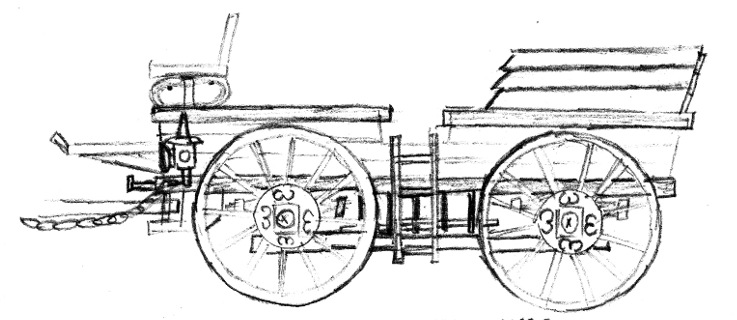
Stage Coaches
There are several stage coach companies along the main roads through Materia. These mainly employ teams of horses for the service, as the animals are cheaper and do not have the legal protections that pelaon citizens enjoy. Often, the horses are pushed to their limits in order to try and achieve higher speeds than their competition.
These coaches also can be used to transport the mail on contract with the government.
Stage coaches are often ornate and fully enclosed, offering anywhere from one to three compartments and space for 6-12 passengers and light luggage. Elaborate leaf springs are employed to provide a more comfortable ride.
Coach companies often own or contract with inns along the road which are spaced a day’s trip apart. Lodging at these inns will frequently be included in the contracted cost of the travel.
Some older coaches are purchased by pelaons to be used in their transport services.
Dry Sleds
Several pelaon species can be found using racks called sleds made for year round use. These are generally made of wood or iron and consist of two parallel runners connected by an arched structure. This structure in turn supports a flat surface or basket at the top where goods can be secured. Some of these can have simple wheels on the ends of the runners in order to minimize wear on harder surfaces.
Medium and larger species find these devices useful for the transportation of personal goods. They can be held on horizontal or shallow-pitched backs, and secured across the torso or dragged behind attached to a dragging tail. In either arrangement, the sled can be secured in a way that one can place or remove it oneself with minimal strain and without needing much or any assistance from others, making it a preferable tool for travelers. The latter position, loaded with heavy cargo, can also be useful when training oneself to not swing one’s tail too wide while walking or aid in posture for better health and endurance.
Sleighs
In the winter months, wagons and stage coaches are replaced with sleighs in the northern portion of the continent. Some wagons are equipped with locking axles that can have skis mounted to the wheels when needed an removed when not. These are most useful for journeys when snow is present but sporadic. In those cases, skis can often be secured onto the underside of the vehicle when not needed.
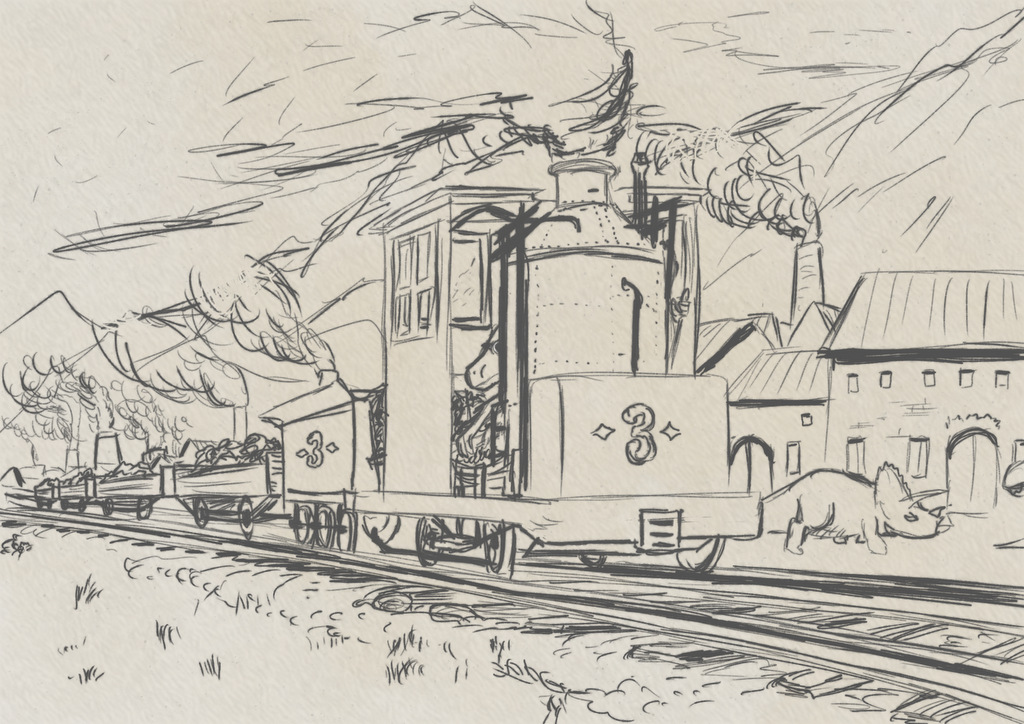
Railway
Coal powered steam engines have been used for many years to haul coal and ores from mine shafts around Pittston, and to a lesser extent at other mines across the continent. These are used both as stationary machines with winches and chains, or as self propelled wheeled machines pulling trains traveling along rails.
After much debate, a railroad network is being built to connect Pittston, Borriston and eventually Ale’s Ferry and Husen. The steam locomotives are used on occasion but most transport remains pelaon or horse drawn wagons running on the tracks for the smoother travel and ease of movement compared with roads.
By Sea
Very few watergoing vessels are constructed for deep sea travel. The majority of ships are wide-beam with a relatively shallow draft, much like a barge. This allows for more balance in relationship to the ship’s displacement considering the overall weight of cargo or passengers. This also prevents problems navigating over the ferry cables in the bay.
Most powered ships are sailing or oar powered vessels. There have been some experiments with paddle wheel vehicles, but most of these are pelaon-on-treadmill powered in order to minimize use of steam power.
Trade Ships
These vessels travel along the shore from port to port transporting and trading goods. Many of these are owned by their captain. These may contract with multiple sellers to transport their goods, or the ship captain may buy and sell goods themselves.
Transport Ships
These passenger transports are often used by the wealthier citizens and are designed to travel at higher speeds than cargo and trade vessels. They are often narrower but those also offer an additional deck level and a deeper draft to balance the vessel. Sleeping compartments are often present for long-distance travel.
Light Cargo Ships
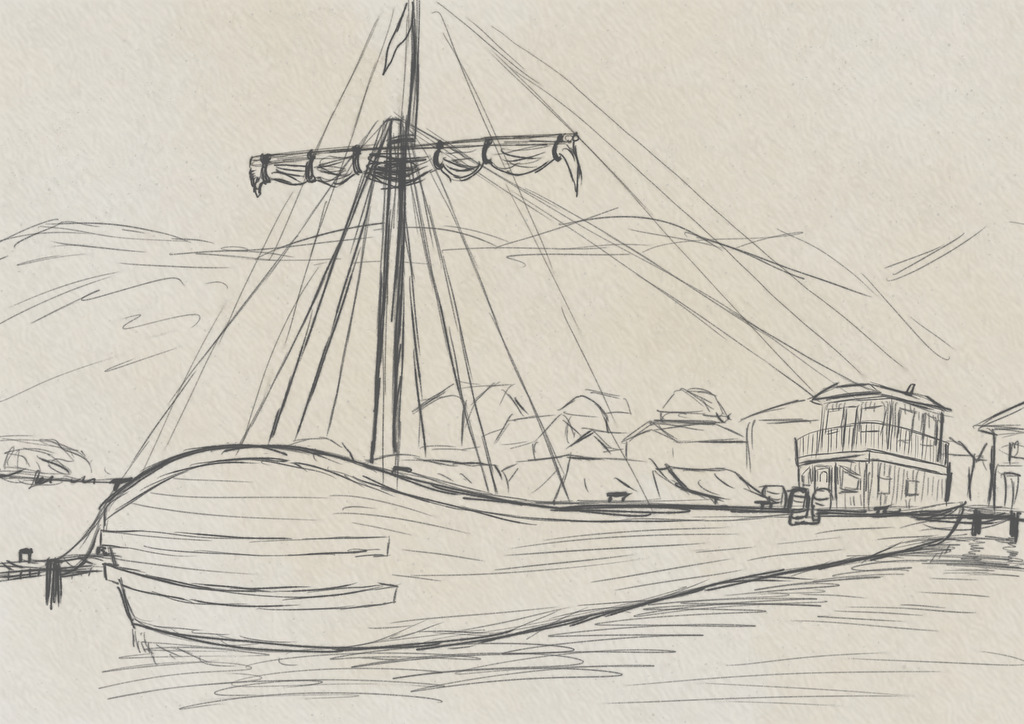
These ships are built similar to transport ships and are designed to carry primarily perishable goods, such as food, quickly between towns and cities.
Heavy Cargo Ships
Wider and more robust than any other ships, these vehicles can transport large quantities of goods from one end of the continent to the other. Because of their size, they are built to travel slower, and have larger and sturdier sails and keel to better control drift. These are often used for manufactured goods, raw materials, metal, and stone.
Bay Ferry
Ferries across the bay between Hull and Ale’s Ferry vary in shape and size. These are generally lighter built craft capable of limited passengers or cargo or a combination thereof. These rarely use sail or other power and instead are connected to one of an assortment of chains and ropes that cross the waterway. Openings or pedistals with openings are located at each end of the vehicle through which one of these cables pass, and the ferryperson, often but not always a pelaon, will pace back and forth pulling the cable against the direction the vehicle is to travel. Some stronger or group ferry persons may sit in place and simply pull the cable.
Ferries are often a place of conversation as the slow, casual crossing takes time and people of all walks and species can find themselves aboard with nothing else to do but talk. It is said ferry owners are the best people to talk to if one is seeking information on gossip or conspiracy.
The ropes and chains drop under the surface of the water across the bay on either side of the ferries, which allows other ships to travel the bay unobstructed.
Fishing Boats
Despite the implied smaller size, these ships are often built strong with a deeper draft and are capable of traveling into deeper waters with minimal risk of capsizing.
These ships also come in various sizes from smaller 5-person boats used in pole fishing for the larger and rarer fish in the sea to the larger ships with crews of 20-30 and large nets to collect smaller and more common fish.
Often, no matter the size of the fishing boat, it is necessary to ask permission of the local swimmer population before casting lines or nets. Some areas are agreed upon by treaty with individuals but those treaties are often in flux.
Diplomatic Ships
A rarity to see as only a few have ever been constructed and they are often kept well secured, these grand ships are ornate and sturdily built, capable of traveling into deep ocean if needed.
Diplomatic ships are designed for the transportation of government officials and for facilitating negotiations with flier and swimmer groups. Each ship is equipped with a balcony and perches strong enough to hold flier diplomats comfortably, as well as a floating platform with a recessed, glass bottom area and equipment to amplify underwater speech so that human and lighter weight paleon diplomats can communicate more easily with swimmers.
The few exploration missions sent to seek the location of Aert or other civilizations have been older diplomatic ships refitted for such a venture.
Cities
Select a city from the list to see more information about that particular community.
Cities in Materia are vast centers of the economy. Many cities are known for specific industries or purposes, however some are simply large communities which have gathered at crossroads, or towns which have expanded their borders multiple times.
By law of Materia, each election must offer at least one candidate for mayor, however an option of no mayor also must be present. Each city is divided into districts and each district elects a representative to sit on that council for 3 years. The council is responsible for the rules and additional laws and social programs within that city but serve also as the local arm of the central Materian government. If a mayor is elected, they may enact temporary (effective for up to 5 years) executive orders, chair the council gatherings, and have some veto power on certain policy types, but they are more an intermediary for the people and have no vote in council deliberations.
Towns
While not vast centers of commerce like cities, towns can still boast significant sizes and populations. Most of these are a mix of brick, stone and wood construction of various architectures. Roads in town may be cobblestone, brick or crushed stone but rarely are left as dirt roadways until one comes to the outskirts. (Across much of the lower continent, many of these can be compared with traditional wild west towns from USA history. In the northern content these towns resemble more late-19th century New England, English and northern European villages.)
Towns often have a governing council, or in some cases are governed by the founding family. Some towns may levy taxes in order to fund maintenance and support the council and its programs.
Agriculture may surround the town, but towns are also supported by trade with nearby agricultural villages and are usually structured like miniature cities in their own right. They can have some two or three floor structures in a downtown shopping area. Often, towns have destination lodging and export specialty materials such as clothing, decorations or other trade goods prepared by craftsmen. For those hoping to make a life in a big city, building a reputation in a town is an essential stepping stone.
Towns of Note:
Rye’s Pass,
a Town in the Borrisdon Area.
Novo Ancour,
a Town in the Bergen Area.
Bonniebreak,
a Town in the .
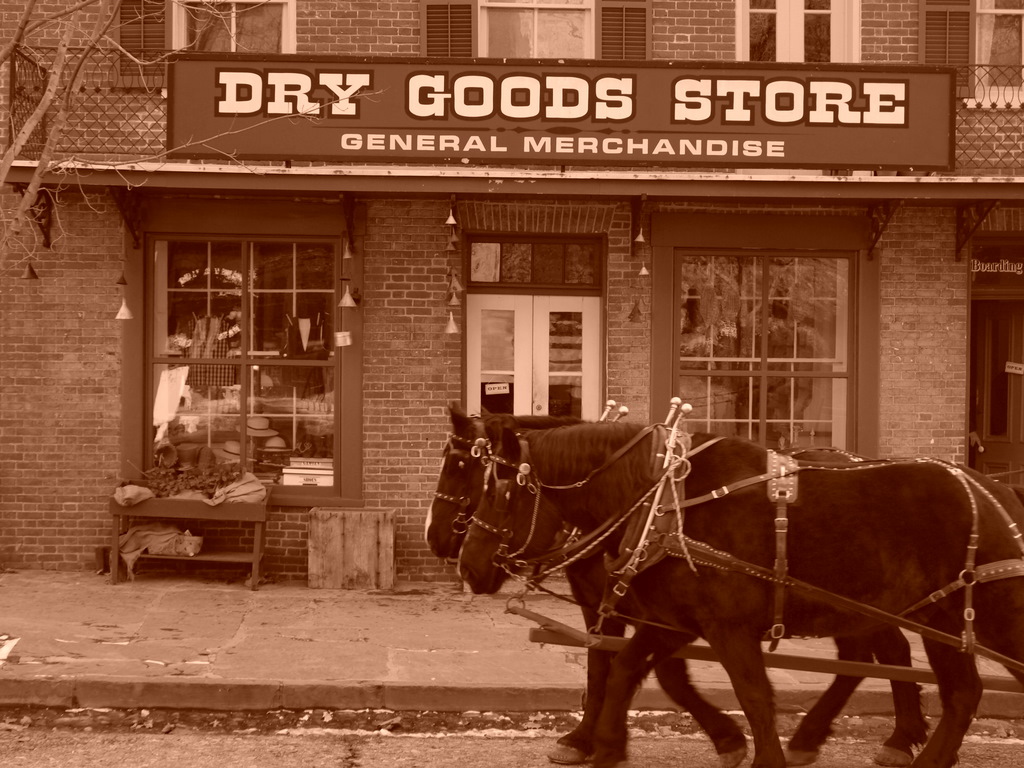
Villages
Wherever two or more homes are built near to one another, you have a village. Most villages are agricultural communities which develop at the center point of several adjacent farms, orchards, and/or vineyards in order to provide protection against raids by purists and pool resources for lodging for farm workers.
Many villages have no name or governing body. Sometimes an elder or trusted individual is chosen to make decisions on behalf of all families in the village. Roads are little more than dirt trails and buildings are often rough-hewn wooden, clay or stone structures. Larger villages may support a general store or other supply business, farm market days to trade produce, and on rare occasion even a tavern. This is especially true of villages alongside or near to a major roadway.
Some Villages:
Life on the Roads
The main roads across the land are often busy places. Wagons and travelers of all shapes and sizes pass in both directions as well as livestock animals being driven by traders and farmers.
Most of the road is dirt . A growing portion of the road is being filled with gravel and stone by nearby towns and villages. Cobblestone surfaces are prevalent in and around cities. Despite attempts to keep the road surfaces flat through the use of road maintainers who work segments of the road with shovel, rake and stone roller, the areas of road farthest from communities is sometimes challenging to travel. Rains cause mud and ruts, drought causes cracks, dust, and bumpy surfaces. In heavily wooded areas, weeds and even small trees try to grow in the roadway despite the heavy traffic with travelers. Streams which cross the road as wide fjords where bridges are not constructed are also known to occasionally wash the road away after heavy storms or winter thaws.
Very few portions of the road are more than 4 hours travel from an inn, tavern, or designated safe resting stop. Often, these can be found clustered relatively close together and wagoners plan their travel around which stopping points they prefer. Some of these have developed into villages and towns centered around the travelers’ amenities and potential for trade.
Technology
Electricity
When humans first arrived in Materia, it was recorded that they were already aware of the use of electricity and installed a rudimentary hydroelectric electrical system in Bacam. As the population grew, these systems began to improve and soon after, charcoal steam generators appeared in the earliest cities. These were improved after the discovery of the first of the continent’s many coal veins.
Fearing the harm that advanced technology had brought upon the homeland that they had fled, the Governance Council of 32 AFB unanimously voted to pass a series of laws and guidelines to severely restrict the use of electrical and steam power in the name of the preservation of society and the natural environment. At the time, the council consisted primarily of first-generation human settlers and the first three pelaons to hold public office.
The general opinion of the population was that of complete agreement. The citizenry at the time were settlers who had fled the horrors of an industrial society seeking a simpler life, their children who had heard tales of the horrors they had fled, or were pelaons who had lived their lives without a need for any technology. As generations have passed, the laws continue to have strong support among the population.
Today, electricity is present only in the largest cities. It is used to light government buildings and the library in Husen, which are often occupied throughout the night by staff. It is also used in Pittston to provide safer lighting around coal storage areas and in mines, as well as powering ventilation fans to maintain airflow out of the mines and keep furnace buildings at more tolerable temperatures. Electric lighting is also used around various ports along the docks for safety purposes.
Steam engines, even stationary engines for operating belt-driven machine shops, must be licensed by the regional governor and fall within a series of legal guidelines. If the use of wind or water power is possible, steam power is rarely approved in its place except as an emergency backup.
Communication
Written correspondence remains the primary source of communication in Materia. To support the heavy demand, there is an extensive mail service which connects every major community and all wagoners and career-travelers on the roads. Outskirt towns also receive mail service but on a less frequent basis.
Light and reflection signals and various flag signals are often used by ships and in more infrequent cases for town to town communications. Flares and fireworks exist in small numbers and are used to indicate emergency situations and call for aid.
There has been debate as to whether telegraph systems should be legalized, as they fall under the electricity restriction, but currently no telegraph network has been installed beyond experimental displays used for amusement and educational purposes in libraries, often used to demonstrate how electricity could be used to power harmful machines if permitted.
Weaponry
Humans make great use of weapons for hunting and self defense. In some cases, pelaons also make use of these devices – often modified – for self defense or security. It is considered inappropriate and dishonorable for a pelaon to catch prey or dine on meat caught with a weapon unless it was caught by a human. It is also considered dishonorable for medium and large pelaons to use weapons for combat.
Pikes and spears are popular multi-use weapons, as they can be used as walking sticks, to carry a bag of goods over a shoulder, test questionable surfaces before stepping on them, and clear overgrowth if needed. Some designs can be used for both hunting and fishing alike. These are often made with a wooden pole that is easily replaced if broken, capped by a metal blade or point, and in some cases multiple points or spurs to hook into prey.
Daggers and knives are also popular for their portability. These are small blades with grip handles of some form, generally kept very sharp and offering a pointed end and blades on either one or both sides of the flat surface. These can be secured at an easily accessible location and serve as defensive weapons, throwing projectiles, and practical uses such as cutting materials for camping or repairs or cutting food during meals.
Swords and machetes, always made in Pittston, are generally used for showing off except when living in the southern tropical forests where they are needed to clear thick brush and vines anywhere off the beaten path. Even so, they are not very strong and will dull or break if not cared for properly, and are too expensive to be practical. These are metal blades (price depending on the quality of metal) which are longer than a knife or dagger but otherwise share many similarities in shape and design.
Bows and crossbows are popular hunting weapons for humans. They are silent, easy to maintain, lightweight and effective. An individual with understanding of the weapons can construct a bow themselves if one is needed but cannot be readily purchased.
A bow is a hardened and generally flat rod of wood carved into a shape which offers some flexibility with tension. The rod is then bent back to hold the tension as a cord is held taught between the two ends. The user holds the center of the wooden rod in one hand, and a pointed shaft called an arrow in the other hand. The arrow will often have feathers, reeds, or stiff leaves serving as fins to help stabilize its flight, and will also have a notch carved into the end opposite the point. The cord of the bow is held within this notch and the arrow pulled back against the tension. When the arrow is then released with a firm grip on the bow itself, the arrow will be propelled at high velocity.
Crossbows operate similarly, however these are only constructed by skilled tradespeople. The structure similar to that of a bow is laid horizontally atop a sturdy structure that is generally held by both hands. When the cable of the bow is pulled back, it is locked in place by a latching mechanism, and a rod similar to an arrow which is called a “bolt,” is laid within a preassigned track against the cable. A lever in the handle, called a trigger or release, is depressed to release the latch holding the cable and the bolt is propelled forward. The tension on a crossbow is often greater than a bow, and the velocity, power, and accuracy of the weapon is greater than that of a bow.
Explosives exist, materials which are packed into containers and ignited in order to cause a large and often destructive explosion of fire. They are, however, highly regulated, and are used primarily around Pittston or stone quarries where they are used for blasting rock.
Black powder weapons, known collectively as guns are the weapon of choice for humans who can afford them, and some pelaons learn to use them for the sport of competitions as with bows. These include short pistols as well as longer muskets. All of these weapons have a metal tube known as a barrel, with one open end called a muzzle. A measured amount of black powder (or “gunpowder”) is poured into the muzzle, followed by one appropriate sized metal ball or several small metal balls. These are packed into the powder using a long stick before additional black powder is sprinkled onto an exterior mechanism and secured. Once the user has aimed the weapon at their target, they pull on a trigger lever similar to that of a crossbow. This trigger releases an armature holding a stone flint which is under spring tension, and the flint strikes a metal piece called a frizzen causing a spark and igniting the black powder in an instant. The explosion caused by this ignition is contained within the gun barrel and propels the ball or balls forward at high velocity toward the target. Due to their shorter barrels, pistols are not as accurate at long range but can be devastating at close range.
Industry
While electricity and steam power are restricted, manufacturing and refining of materials remains a significant business across the continent. Beyond the mines and metal refining facilities in Pittston and its surrounding communities, factories and mills can be found virtually anywhere. Especially in high hills or alongside waterways near communities. Most of these facilities, no matter their function, are powered by either water, animals or wind.
Wind power is generated by sail-like fabric, wood or metal blades – anywhere from three to ten of these blades – which collect the breeze and move in a circular motion around a pivot point. While even gentle breezes will often allow the mill to function, this method can at times be unpredictable and irregular. A similar process is used to pump water from wells deep underground for farms and some communities where other water sources are scarce.
In some cases, animals such as horses or mules – or in some other cases paid pelaons – can provide power by walking stationary on treadmills or inside of wide wheels with a surface to walk on rotating a pole at its pivot point, or walking in a circle around a pivot point pole.
Water power in most cases comes in the form of a water wheel. In this form the movement of a waterway, either underneath or being fed from a point at higher elevation upstream by a trough and poured atop, will push on paddles held perpendicular to the water flow by a pair of sturdy wheel structures. The movement of water causes those wheels to rotate at a steady and generally reliable pace. Some designs use both the overhead and undercurrent methods in tandem for more power. Alternatively, vertical turbines can be used instead. This is a process wherein water flow is restricted into a narrow channel where it passes against a series of paddle blades attached to a central pole, the force of the water rotating that pole. These are often stronger and more reliable but must be built of stronger materials meaning they are more expensive to establish. In either case, a series of ponds are often built upstream to feed the wheel or turbine and provide a more reliable and steady flow of water in a controlled environment.
Agricultural areas often are home to grist mills. These contain a series of round stones connected directly to the power source by a series of poles and gears. Between these stones, grains or dried plants are fed and ground into flours and other usable powder forms. The final product is then gathered into fabric sacks for shipment or storage.
In forested areas, it is not uncommon to find a saw mill. Wood from logging camps will be dragged with various methods to these mills, where guides are used to feed the logs into serrated blades in the form of a very large rotating wheel or a vertical band moving up and down or spinning in the form of a belt. Each form has its own merit and associated costs. In most cases these blades are connected to the power source as directly as possible.
Many other facilities use a central shaft connected to the power source, upon which wheels are attached and these wheels are then connected to multiple machines using sturdy leather belts. Levers and foot petals can be used to provide tension to otherwise slacked belts and “turn on” individual tools rather than all always functioning. Facilities using this process include but are not limited to:
- Textile mills where wool and plant fibers are spun into thread and cable and then fed into looms to produce fabrics
- Clothiers, leatherworkers and other seaming factories where belts can drive punches, cutters, and simple sewing machines.
- Metal shops where the belts power bellows and blowers for smiths, drill presses, lathes, saws and other power tools in order to produce tools, fastners, horseshoes, weapons, wagon wheel tires, guns and more
- Butchers’ abattoirs, where saws of various sizes are powered to slice through meat and bone
- Some tanneries and furriers will use rotating brushes to clear meat from hides
- Manufacturers of wood products using saws and sanding belts
- Glassmakers and potters and bakers using blowers to maintain high temperatures in kilns and ovens
- Workshops and larger buildings can also use belt driven ceiling fans and vent fans to circulate air and maintain comfortable temperatures.
- Paper, dye, and plant-based ink manufacturers needing constant mixing of their various product offerings during production.
- Nearly any other business which could make use of mechanical equipment.
